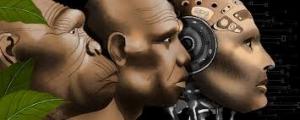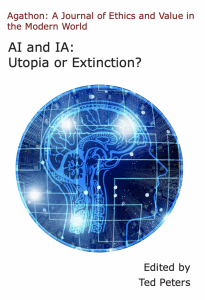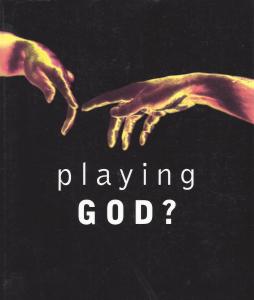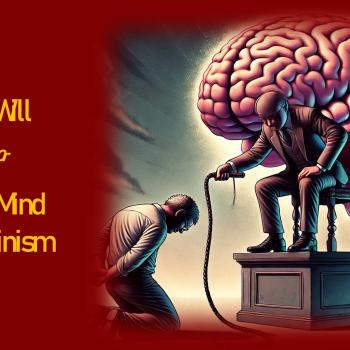 Should we Christians, Jews, and Muslims board the transhumanist train? Should we ask for our own coach labeled, “Religious Transhumanism”? If so, how far should we ride? All the way to the posthuman destination? Is a religious transhumanism conceivable?
Should we Christians, Jews, and Muslims board the transhumanist train? Should we ask for our own coach labeled, “Religious Transhumanism”? If so, how far should we ride? All the way to the posthuman destination? Is a religious transhumanism conceivable?
The public theologian is boarding the transhumanist train, but tentatively. One foot furtively taps the boarding platform. The zephyr is ready to leave the station and to speed toward the future. Should the public theologian accelerate the transhumanist’s velocity? Or slam on the brakes? Switch to a different rail?
Public theology, I maintain, is conceived in the church, reflected on critically in the academy, and meshed within the wider culture for the benefit of the common good. Much of the public theologian’s contribution takes two forms: discourse clarification and worldview construction. As an exercise in discourse clarification, we will here ask whether transhumanism — also known as Humanity Plus or H+ –can share a track with Protestants, Roman Catholics, Unitarian Universalists, Jews, Muslims, and Mormons. Would we want a coach on the transhumanist train labeled, “Religious Transhumanism”? Some of our closest friends are already reserving seats.
This post continues a previous discussion in our series on religious transhumanism and its critics: “Is AI a Shortcut to Virtue? Or to Holiness?” A future post will continue discourse clarification: H+ 3: Radical Life Extension? Cybernetic Immortality? or Resurrection of the Body? More will likely follow. Here is some of what is coming.
Religious Transhumanism 4: Evangelical? Yes
Religious Transhumanism 5: Mormon? Yes
Religious Transhumanism 6: Jewish? No
Religious Transhumanism 7: Buddhist? Yes
Religious Transhumanism 8: UU? Yes
Religious Transhumanism 9: Christian Transhumanism versus Transhumanist Christianity
Religious Transhumanism 10: Transhumanism vs Posthumanism
Religious Transhumanism 11: What about the body? A Lutheran Response
Religious Transhumanism 12: Catholic?
Religious Transhumanism 13: Methodist?
Religious Transhumanism 14: is it scientific?
Hybrid scientist-theologian Arvin Gouw fears H+ might misguide religious sensibilities. Two salient yet misguiding themes unite AI robotics with transhumanist eschatology. The first is that we Homo sapiens can do on our own through technology what God has promised. The second is an over-evaluation of intelligence. The public theologian will press the question: which is our summum bonum or highest good: intelligence or love?
The Future as Futurum and Adventus
To aid us in discourse clarification, the public Christian theologian should distinguish between two ways of describing the future. First, the future as futurum is commonly known as progress. Such a future is that which we make out of resources drawn from the past. Adventus, in contrast, is that dimension of the future that only God can create. Every moment God’s adventus releases us from the deterministic grip of past causes so that we created co-creators can advance the progress of futurum. On the one hand, adventus belongs to the consummate eschatological future while, on the other hand, adventus right now also makes possible futurum’s creativity. In short, God opens the future every moment for our creativity to make an impact. But, that’s a story for the systematic theologian to tell on another occasion.
Technological progress is futurum at work. The Bible’s eschatological promises point us to the advent of God’s transformatory kingdom. Once we have been transformed, then we will be what God has always intended us to be. We will be truly human. Is it the job of religious transhumanism to announce this? (Evolution sculpture by Pari Danadoost)

Engineering the Human and Posthuman Futures
Piloting futurum’s zephyr is the transhumanist engineer, Oxford’s Nick Bostrom. The posthuman condition in Bostrom’s scenario includes these characteristics.
- Population greater than 1 trillion persons
- Life expectancy greater than 500 years
- Large fraction of the population has cognitive capacities more than two standard deviations above the current human maximum
- Near-complete control over the sensory input, for the majority of people for most of the time
- Human psychological suffering becoming rare occurrence
- Any change of magnitude or profundity comparable to that of one of the above
Transhumanists are not timid. They press the buttons of evolution’s control panel to design a future which, at least in the first phases, will be controllable. Once H+ yields the control panel to Ray Kurzweil’s forecasted Singularity and then to its posthuman product, we Homo sapiens will be left behind. Robosapiens will replace Homo sapiens.

The new posthuman will be immortal. Those of us who make it all the way to the posthuman destination will enjoy either radical life extension (RLE) in the body or cybernetic immortality (CI) out of the body. CI requires that our mind be uploaded into the computer cloud. Immortality? Living forever? Really?
The Transhumanist Manifesto challenges the issue of human aging and the finality of death by advocating three conditions. These conditions assert that (1) aging is a disease that medical science can cure; (2) augmentation and enhancement to the human body and brain are essential for survival, and that (3) human life is not restricted to any one form or environment. Death is not inevitable. Via either RLE or CI, our posthuman descendants will have the option of living forever.
An Apotheosis of the Posthuman? Really?
The terminal station on this techno-posthuman route is nothing short of apotheosis itself. Our H+ friends intend to self-make today’s human into tomorrow’s deity. “Having raised humanity above the beastly level of survival struggles, we will now aim to upgrade humans into gods, and turn Homo sapiens into Homo deus,” touts bestselling author Yuval Harari (Harari 2017, 21). Deification will be achieved through techno-can-do-ism, following the path of a futurum we ourselves make. We cannot avoid asking: are the hubris of Prometheus and the recklessness of Frankenstein putting our human future at risk?
“Transhumanism is a philosophy, a worldview and a movement,” declares Natasha Vita-More, Executive Director of Humanity + Inc. (Vita-More 2018, 5).
Transhumanism is the process by which the posthuman comes into being. Transhumanism is about transcendence, about the future transcending the present. “Why I want to be a posthuman when I grow up?” Nick Bostrom is ready to pass through transhumanism to get to posthumanism.
Religious Transhumanism? Really?
Where is the religious mind in all of this? Christians–whether of Syriac, Byzantine, or Latin tradition–have long thought of the decisive future as adventus, as God’s future. God’s ultimate future nullifies what has been evil in history. God’s future selects what has been wholesome. God’s future transforms the present creation exhaustively, totally, consummately. God’s future offers salvation.
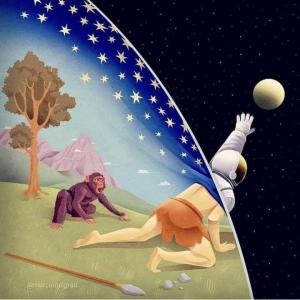
For Christians, Jesus’ Easter resurrection from the dead provides the model or prolepsis of the advent of the new creation. A new creation, including eternal life, is a gift of God to those of us who are subject to death. Redemption is a gift of divine grace, not the achievement of human technology. The truly human is the human raised from the dead by God.
So, I ask: why might religious people be interested in a transhumanist version of futurum? If Christian hope directs our attention to divine transformation in the form of adventus, this means no Christians would embrace religious transhumanism. Right? Wrong.
Religious critics of transhumanism fear it will crash into a Dark Mountain. Despite critical assessments of transhumanism by theologians and other scholars, a syncretistic religious zeal propels many of the faithful. (Mercer and Trothen, 2021) Let’s see what Protestants, Roman Catholics, Jews, Muslims, Unitarian Universalists, and Mormons say about religious transhumanism.
The Christian Transhumanist Association (CH+)
The Christian Transhumanist Association (CTA) arose among Evangelical Protestants in 2014. Christian blogs merged with H+ and social media. CTA augments H+ with XH+, where the X or chi represents Christ.
What is the CTA mission? “We believe that God’s mission involves the transformation and renewal of creation.” This is followed by “we believe that the intentional use of technology, coupled with following Christ, will empower us to become more human.” Let me call your attention to this wording: “more human.” Not “posthuman.” CTA is dedicated to the truly human, the sanctified human.

For sparkplug Micah Redding, founder and president of CTA, H+ is not itself the end but rather a means for effective Christian mission. That mission includes spiritual progress, especially sanctification. “Christian Transhumanists will continue to advance the vision of a radically flourishing future that is good for all life” (Redding 2019, 794). Similarly, theologian Michael Burdett at the University of Nottingham borrows from technosapienistic zeal to help insure human personhood and human flourishing in an age of techno-domination.
Yet, the Christian theologian dare not be naive about anthropology, especially the doctrine of sin. When utopians forget about human sin, a not very hidden ice berg sinks the ship. Carmen Fowler LeBerge issues a warning. “The Christian must ask (and be prepared to explain) what it means to the transhumanist to be human and we must also be prepared to expose the sin-side of their plans. For while there may be much good in longer life, sin remains and sin is prone to ruin good things and the good life so many pursue. We have to face the fact that people – even highly evolved people – have done, are doing and will continue to do horrible things” (LaBerge 2019, 775). Religious transhumanism, in short, offers great promise for the Christian mission. Yet, at the same time, we must be wary that H+ might be a wolf in sheep’s clothing.
Roman Catholic Diffidence
If the transhumanists are selling radical life extension or cybernetic immortality, are the Roman Catholics buying? Can a Roman Catholic rally around the RLE promise of immortality?
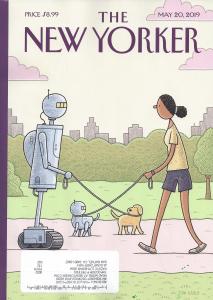
No, not quite. University of Saint Thomas theologian Terence Nichols distinguishes between what RLE plans to deliver and the Christian understanding of resurrection to eternal life. Futurum and adventus are not the same. What RLE promises is a lengthening of life as we know it for those now living; whereas “the crucial point in the New Testament is that eternal life can only be attained through and after death. It is not the result of an indefinite postponement of our physical death; it is the gift of God after death….Eternal life, therefore, is not reached by an indefinite prolongation of life in this physical body; it is reached after bodily death in state that transcends this physical body” (Nichols 2009, 135-136).
When it comes to Roman Catholic ethics, Santa Clara University professor Brian Patrick Green would filter the benefits of human technological enhancement through an ethical sieve. “I believe that Christians should be a particular kind of techno-progressive, specifically one which seeks to use technology for the sake of human development. Specifically, as with all issues of moral salience, we need to direct technological developments towards good and away from evil” (Green 2017, 12).
Despite sharing a positive vision of the future, the H+ vision and the Christian vision are not isomorphic. The concept of the future with which transhumanism works is futurum, whereas for the Christian the future is envisioned primarily as adventus. This means for Reformed theologian Ronald Cole-Turner that a Christian looks to what transcends this life, namely, to resurrection tomorrow which translates into a life of love today. “’Losing one’s life’ for the sake of Christ is not physical death but a living surrender or, as Paul puts it, a ‘living sacrifice’ (Romans 12:1). By letting go of their lives, Christians believe that they are given a life that is far greater, a life (like Christ’s) that is lived for others, and therefore a life that is eternal” (Cole-Turner, Going Beyond the Human: Christians and Other Transhumanists 2015).
Jewish Rejection
Traditional and contemporary Jewish thinkers tend to be accepting of human limitations such as suffering and death. This is due either to the way the vicissitudes of life are biblically acknowledged; or it is due to the fact that they are natural endowments. This makes the perfectionist or messianic tone of H+ unnerving to Jewish sensibilities.
Israel-born Hava Tirosch-Samuelson at Arizona State University refuses to board the H+ train. She fears the technological fetishism of H+ has become a form of techno-idolatry. “I view transhumanism as an elaborate pursuit of perfection….I reject transhumanism because it calls for the planned obsolescence of the human species on the grounds that biological humanity, the product of a long evolutionary process, is not only an imperfect work in progress but a form of life that is inherently flawed and has no right to exist” (Tirosch-Samuelson 2018, 203). The H+ train will depart without this Jewish scholar on board.
Islamic Diffidence
No Muslim will board the H+ train without the Qur’an in hand. For the Muslim, any consonance with contemporary science must presume the authority of a literal reading of the Qur’an. At first, the prospect of immortality in the form of RLE looks like a conflict, because the Qur’an makes it clear that “every soul will taste death.”

Does this preclude every form of earthly immortality? Prodigious Islamic scholar Aisha Musa searches for an interpretation that might admit compatibility with RLE. She finds one. She recognizes that the universe has a finite future—that is, at some point, all of physical reality will disintegrate. This end to the universe will also mark an end to the physically immortal beings who live in it. Even the immortals will finally perish, and the Qur’an will have turned out to be correct. “Because RLE does not necessarily imply immortality, it does not necessarily conflict with the Quranic teaching that every person will experience death.” Regardless of how much H+ technology might accomplish, human life extension applies only to this life prior to death. Only through death will our relationship to Allah, according to Quranic teaching, be fully realized.
Enthusiastic Mormon Religious Transhumanism
Mormon Transhumanist Association leader, systematic theologian Lincoln Cannon, asserts boldly that “Mormonism actually mandates transhumanism…one cannot be a Mormon without being a transhumanist.” Looking at Mormon scriptures with one eye while looking at the H+ plan for immortality with the other, Cannon claims that “God commands us to use science and technology to help each other attain Godhood….to make us immortal in eternal life” (Cannon 2015, 213). In short, techno-transhumanism will aid the Mormon to achieve a spiritual goal, namely, posthuman Godhood. Mormonism and H+ are cannonballing down the same track.
Enthusiastic Unitarian Universalist Religious Transhumanism
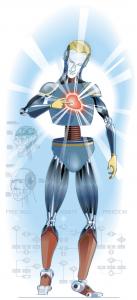
It appears that transhumanism and Unitarian Universalism are already on the same track. “We have a unique gift because of our uniquely humanist understanding, whether theist or non-theist, that humanity is called to be co-Creator of our own future,” says James Hughes in a landmark article. The Transhumanist UU Network provides a web parlor for ongoing discussion. (Robot diagram by James Abundus, Seattle Times 2019)
UU transhumanists believe they are mandated to play God on their way to actualizing our divinity within. Theomimesis, literally ‘imitating God’, is the term for playing God. “Theomimesis (‘God-playing’ in Greek) is our neologism for attempts to acquire God’s point-of-view…what might be called the transhumanist telos” (Fuller 2014, 48).
Secular Techno-Religion
Overt religious transhumanism is one thing. Covert religious transhumanism is another thing. If secular transhumanism feigns secularism yet appeals to religious sensibilities, might we have a wolf in sheep’s clothing?
If H+ is already about transcendence, might the H+ fetish for technology inspire its own religion de novo? If H+ treats technological progress as ultimate rather than strictly penultimate, will the computer become something spiritual? If you answer in the affirmative, then why not join a church named after the father of computing, Alan Turing? Try Giulio Prisco‘s religion. “Turing Church is a group of seekers at the intersection of science and religion, spirituality and technology, engineering and science fiction, mind and matter. Hacking religion, enlightening science, awakening technology. Exploring outer and inner spaces.”
Should Transhumanists Play God?
UU and Mormon transhumanists positively advocate playing God for the betterment of humanity. Non-religious or even anti-religious transhumanists proudly play God as well. So, a critic might ask: does playing God call upon the tradition of Prometheus and Frankenstein? Is there risk of tragedy here?
Here’s Simon Young. “From Prometheus to Frankenstein, the myth of punishment for challenge to the Gods derives always from the same cause: the stoical acceptance of human limitations deemed impossible to overcome—and the cowardly fear of the unknown…..Let us reject irrational hubraphobia and seek to improve our minds and bodies in any way we can” (Young 2006, 50).
When traditional religion vacates and leaves a spiritual cavity, it appears that the myth of Prometheus in its Frankenstein form fills in to satiate the non-religious worldview.
The New Adam is Calling Us to be Truly Human
The public theologian may want to appropriate Christian anthropology here. We human creatures are being called forward by the new adam, the God-intended truly human. Our present restlessness is a sign that we are not now what we will yet be. The tensions between soil and spirit, between biology and pneumatology, between sin and grace are signs of our continuing creation. These signs draw us forward toward what we will finally become. The adam of Genesis, to whom we are presently heir, was subject to tragedy in a way that the new adam, who participates in the resurrection of Jesus Christ, will not be. Saint Paul struggles to paint a picture of who we will be, namely, God’s intended truly human.
Thus it is written, “The first man Adam became a living being”; the last Adam became a life-giving spirit. But it is not the spiritual that is first but the physical, and then the spiritual. The first man was from the earth, a man of dust; the second man is from heaven. As was the man of dust, so are those who are of the dust; and as is the man of heaven, so are those who are of heaven. Just as we have borne the image of the man of dust, we will also bear the image of the man of heaven. (1 Cor. 15:45-49)
Christ as the New Adam is the first instantiation of our eschatological fulfillment. “Our reconciliation with God-like the ‘great turn of the ages’ in the death and resurrection of Christ which accomplishes it—is ‘the fact’ from which all else follows” (Ziegler October 2016, 9-10) . In our resurrection, we will have become truly human.
Religious transhumanism seems superfluous if not diversionary to one who places hope in the biblical promises of resurrection into the Kingdom of God.
Comparing Transhumanist and Biblical Eschatologies

Will we have fulfilled the dream of immortality that is promised in Christian faith once our bodies are enhanced enough to live for an indefinite span of life? The answer is quite clearly, No, according to philosophical theologian Benedikt Göcke, (Resurrection by Glenn Bautista)
Although Christians fully enjoy being alive and, in normal circumstances, seek to lengthen their time in this world in order to do good and to recognize and respond to the grace of God, the transhumanist vision of what often is misleadingly called “immortality” is theologically irrelevant. First, even an enhanced human body that knows no natural death is not an invulnerable human body and can be killed or destroyed in numerous ways. Second, our universe has only a finite existence and, according to the second law of thermodynamics, is bound to come to a state in which life is impossible. As a matter of physical necessity, human subjects cannot lead an infinitely long life in this world. Third, from a Christian point of view it is not the duration of a particular human life that is important but the moral quality of the life led and the human individual’s response to the call of God. A short life can be morally exemplary, and along or an indefinitely long life can be morally horrendous in the eyes of God. The duration of a human life is therefore eschatologically irrelevant. (Göcke, 361).
Not immoral. Irrelevant.
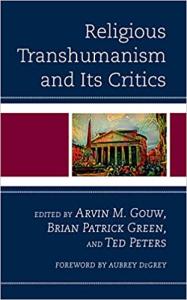
For you or me to answer this call from the future to become the new adam, we must trust in God’s adventus rather than the heroic futurum of H+.
Let me mention that three of us–Brian Patrick Green, Arvin Gouw, and I–are editing a new book, Religious Transhumanism and its Critics, just published by Roman & Littlefield. You, dear reader, have just been introduced to the themes of this forthcoming book.
If our transhumanist friends–both religions and nonreligious–are able through technology to enhance our potential for human flourishing in this life, let’s offer them a heartfelt thank you. We need only to keep in mind the distinction between penultimate futurum and ultimate adventus.
▓
Dr. Ted Peters (Ph.D., University of Chicago) teaches systematic theology and ethics at the Graduate Theological Union in Berkeley, California, USA. Along with Robert John Russell, he co-edits the journal, Theology and Science, at the Center for Theology and the Natural Sciences. He is author of God–The World’s Future (Fortress, 3rd ed., 2015) and author of Playing God? Genetic Determinism and Human Freedom (Routledge, 2nd ed., 2003). He recently edited a new volume on artificial intelligence, AI and IA: Utopia or Extinction? (ATF 2018) Along with two colleagues, Arvin Gouw and Brian Patrick Green, he is now editing a new book, Religious Transhumanism and its Critics (Lexington 2022). He is author of a fiction thriller with a Transhumanist plot, Cyrus Twelve, with Aprocryphile Press. Visit his website: TedsTimelyTake.com.
▓
Bibliography
Cannon, Lincoln. 2015. “What is Mormon Transhumanism?” Theology and Science 13:2 202-218.
Cole-Turner, Ronald. n.d. “Extreme Longevity Research: A Progressive Protestant Perspective.”
Cole-Turner, Ronald. 2015. “Going Beyond the Human: Christians and Other Transhumanists.” Theology and Science 13:2 150-161.
Göcke, B. Paul. 2017. “Christian Cyborgs: A Plea for a Moderate Transhumanism,” Faith and Philosophy 34:3: 347-364,
Green, Brian Patrick. 2017. “The Catholic Church and Technological Progress: Past, Present, and Future.” Religions 8:6:2-16 file:///C:/Users/Ted/Downloads/religions-08-00106-v2.pdf.
Harari, Yuval Noah. 2017. Homo Deus: A Brief History of Tomorrow. New York: Harper.
Herzfeld, Noreen. 2009. Technology and Religion: Remaining Human in a Co-created World. West Conshohocken PA: Templeton Press.
LaBerge, Carmen Fowler. 2019. “Christian? Transhumanist? A Christian Primer for Engaging Transhumanism.” In The Transhumanism Handbook, by ed. Newton Lee, 771-776. Switzerland: Springer.
Mercer, Calvin, and Tracy Trothen. 2021. Religion and the Technological Future. New York: Macmillan.
Nichols, Terrence. 2009. “Radical Life Extension: Implications for Roman Catholicism.” In Religion and the Implications of Radical Life Extension, by eds. Derek F. Mather and Calvin Mercer, 133-144. New York: Macmillan Palgrave.
Peters, Ted. 2019. AI and IA: Utopia or Extinction? Adelaide: Australian Theological Forum.
Peters, Ted. November 2021. “Enhanced Intelligence and Sanctification.” Living Lutheran 24-25.
Redding, Micah. 2019. “Christian Transhumanism: Exploring the Future of Faith.” In The Transhumanism Handbook, by ed. Newton Lee, 777-794. Switzerland: Springer.
Russell, Stuart. 2016. “Should We Fear Supersmart Robots?” Scientific American 314:6 58-59.
Tirosch-Samuelson, Hava. 2018. “In Pursuit of Perfection: The Misguided Transhumanist Vision.” Theology and Science 16:2 200-223.
Young, Simon. 2006. Designer Evolution: A Transhumanist Manifesto. Amherst NY: Prometheus Books.
Ziegler, Philip. October 2016. “A Brief Theology of Reconciliation.” Touchstone 34:3 7-13.


